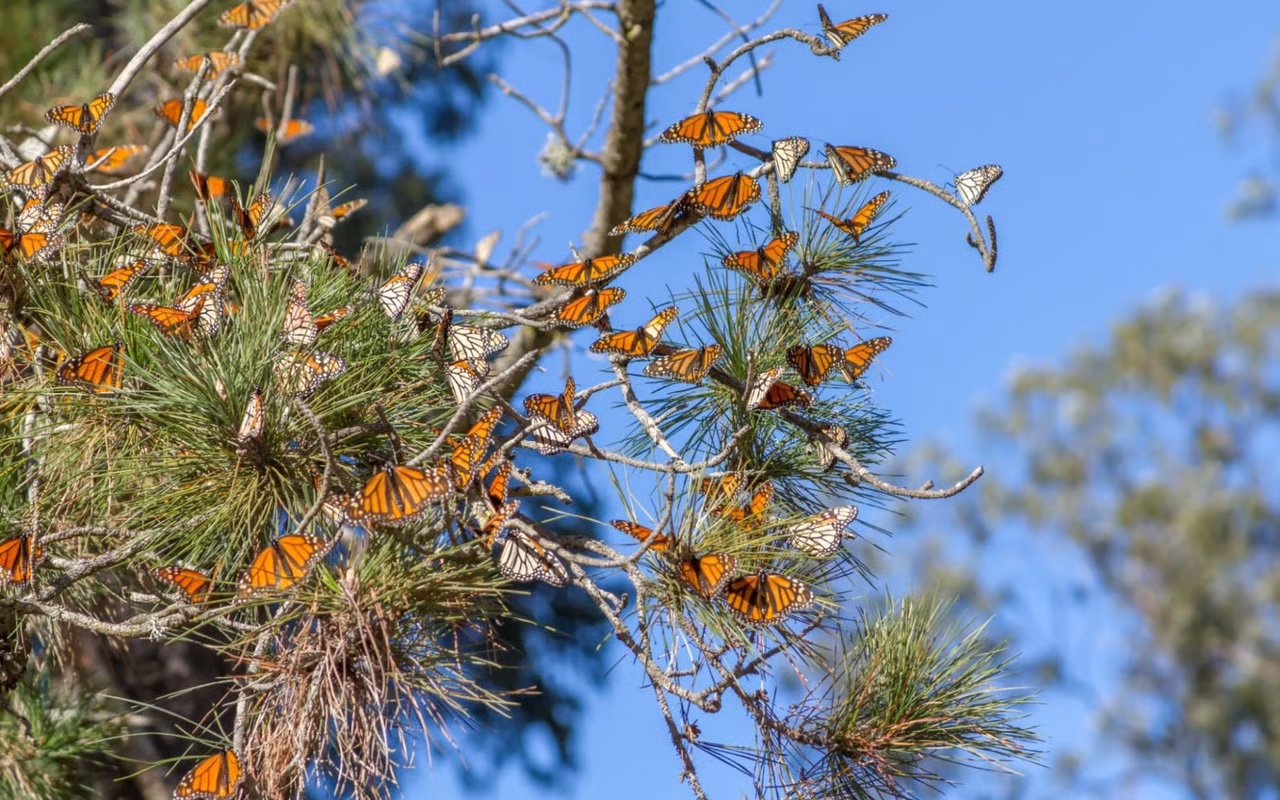Pismo Beach is a classic beach town located along California’s famous central coast where residents stroll along the spectacular white beaches to horseback ride, surf, or fish. The city is home to many amazing restaurants, shops, and activities and also the Monarch Butterfly Grove.
When it gets cold, the monarch butterflies begin their 2,500-mile annual migration south. There are a few places to see them along their journey, but the Monarch Grove is the largest on the west coast. In a single season, researchers have counted up to 230,000 Monarch butterflies. The Grove is the only site that regularly counts the number of butterflies to track their population and is one of only five states that counts over 10,000 butterflies yearly.
What butterflies are at the grove?
The Western Monarch butterflies call the Monarch Butterfly Grove home for a few months. The butterflies live west of the Rocky Mountains and migrate between southern Canada and San Diego. Butterflies have a life span of six months, and some scientists believe that they are equipped with natural homing systems that lead them from their summer homes to their winter locations.
Researchers believe the antennas are key to their migration and act like a clock to provide the butterfly with information about the time of day. It’s estimated that the sun’s position, along with the information provided by the antenna, is key to their navigation. On cloudy days, scientists infer that monarchs use a geomagnetic compass that is triggered by UV light as a navigational system.
The butterflies travel to Pismo Beach to escape the cold winters in the Rockies. Western Monarch butterflies can fly over 1,000 miles to reach their next migration point. They can fly over 100 miles a day and at altitudes of as high as 10,000 feet. Unlike other migratory species, Western Monarch butterflies make their migration journey for the first time and have never been to their destination before. Western Monarch butterflies are typically found in the Grove beginning in mid-October, with a peak season in November through January.
The colony at Monarch Butterfly Grove is one of the largest in the nation, with an average of 25,000 Western Monarch butterflies making the grove their winter home. From October to February, the butterflies form bundles on the top of eucalyptus trees throughout Monarch Butterfly Grove. This grove is accessible from State Highway 1 at the southern boundary of Pismo Beach. The Eastern Monarchs have recently adjusted their flightpath to travel along the coast and inland valleys.
Where to see Monarch butterflies
You can see Western Monarchs on their migration from the Monarch Butterfly Grove. A sunny winter day provides ideal conditions to see the Monarch butterflies along Highway 1. However, the Western Monarch Trail is the best site to see the butterflies. There is information throughout the Western Monarch trail that educates visitors about the health of the Monarch butterfly’s population.
The sites along the route provide shelter, nectar, and native milkweed, which the butterflies use to feed their larvae. Signs along the trails are updated to provide current information on their status and efforts to restore their population. The Western Monarch butterflies are at greater risk of extinction because of increased development, loss of the milkweed habitat along their migratory routes, and severe droughts.
There are multiple sites, including the Pismo State Beach Butterfly Grove, Hueneme Masonic Cemetery, and Carpinteria Creek. Though not all sites are open to the public, ten of the sites are located in the county alone. The Western Monarch trail is operated in partnership with the Central Coast State Parks Association and other organizations that are working to preserve natural resources.
Volunteers have set up telescopes along the trail to help visitors see the butterflies in the trees, and the volunteers are knowledgeable about the butterflies and their habitat. Visitors can also find more information, books, apparel, and butterfly-related items at the Monarch Mercantile Trailer, which the Central Coast State Parks Association operates. There is also a campground, and the grove is a great place to spend the day. Along the trail, you will come across an estuary at the edge of Pismo Beach, where you can see flocks of birds around the shoreline.
When to see the butterflies
The Monarch Butterfly Grove in Pismo Beach is open all year, but the best time to see the butterflies is from November to February. The butterflies migrate south at the start of winter and begin their migration north as the weather warms in the spring. Monarch butterflies spend the winter in Pismo Beach, Morro Bay, and Pacific Grove. The Natural History Museum in Morro Bay and the Oceano Dunes District Visitor Center provides detailed information about the butterflies.
During the winter, many butterflies enjoy spending time on the nectar beds on the south of the trail and are in flight in the morning or on sunny days above 55 degrees Fahrenheit. It will be important to look closely, as clusters of butterflies can look like pinecones or brown leaves. Anyone can visit the grove, and they also provide school groups, field trips, and virtual field trips. The Pismo Beach Monarch Butterfly Grove is free and open daily from sunrise to sunset. There are also picnic tables and a gift shop on the grove.
The Monarch Butterfly Grove is centrally located, and there are many opportunities to enjoy the natural resources and beauty of Pismo Beach. You can take in the stunning sunsets over the pristine white beaches, walk on the award-winning boardwalk on Pismo Pier, or explore the wineries and restaurants the area has to offer.
After spending time at the Monarch Butterfly Grove in Pismo Grove, you might be interested in looking at homes for sale in Pismo Beach. Working with an experienced realtor can help you find your dream home in this gorgeous area. Contact the Weber Team Real Estate to begin your home search today. Their team of experts looks forward to assisting you in your real estate journey.

